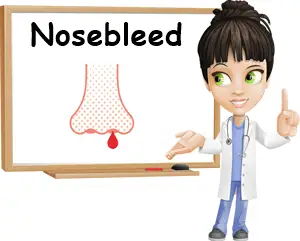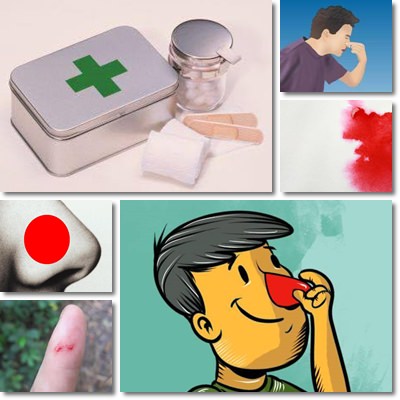Nosebleeds are characterized by the loss of small amounts of blood from the nasal cavity. Blood can flow outwards from the nose or, rarely, drip down our throat into the stomach, potentially resulting in symptoms of nausea and vomiting.
Generally, nosebleeds are a benign occurrence. However, when the bleeding is significant and cannot be controlled easily or occurs frequently and repeatedly, medical attention is required.
Both children and adults may experience nosebleeds on a fairly regular basis, often as a result of minor irritation, injury to the nose or nose lining, dry air or foreign bodies in the nose.
For the most part, nosebleeds are harmless and can easily be dealt with at home or at the doctor´s office. Measures to control, prevent and treat nosebleeds are diverse and depend primarily on the cause of the bleeding.

The nose is a highly vascular area with a sensitive lining that is easily prone to irritation, injury or infection and bleeding. Its central position in the middle of the face further adds to the risk of blunt trauma and injury that could result in bleeding, hence the frequency of nosebleeds (epistaxis). However, the severity of a nosebleed depends primarily on its type.
Types of nosebleed
1) Anterior nosebleeds are the most frequent type. It is estimated that about 90% of all epistaxis cases are anterior nosebleeds. This means that the blood dripping out of the nose comes from blood vessels in the front part of the nasal cavity, hinting towards a benign cause, most probably a minor injury (picking, irritation, infection, minor trauma). Anterior nosebleeds are easiest to manage due to their superficial nature.
2) Posterior nosebleeds account for a smaller percentage of nosebleeds and usually indicate a more serious cause due to the fact that the bleeding originates in the blood vessels situated deep in the nasal cavity. Bleeding is harder to manage, more substantial and requires medical attention for proper diagnosis and treatment (cauterization or nasal packing may be necessary).

Potential causes Nosebleed
Nosebleeds occur because of various causes, some more evident than others. Here is a list of the most probable 20 causes of nose bleeding:
1) Injury or blunt trauma (blow to the face).
2) Nose picking, sniffing or blowing the nose too hard.
3) Foreign bodies in the nose (often seen in children).
4) Respiratory tract infections (common cold, flu, sinusitis, bronchitis).
5) Allergic rhinitis and allergies in general.
6) Chemical irritants (in cleaning products, for example).
7) Low humidity (causes the nose lining to dry up and crack).
8) Cold weather (damages the sensitive nasal mucosa).
9) Excessive sneezing.
10) Blood thinning medication such as aspirin or warfarin.
11) Anti-inflammatory medication (mostly when taken in large amounts).
12) Prolonged use of nasal decongestant sprays.
This also results in rebound congestion and may further accentuate the problem, potentially leading to nasal decongestants addiction. See side effects of nasal decongestants.
13) Blood clotting disorders.
14) Hypertension (high blood pressure).
15) Blood vessel abnormalities, deviated septum and other structural abnormalities.
16) Alcohol consumption (causes blood vessels to dilate) and smoking.
17) Hormonal changes and hypertension during pregnancy.
18) Vitamin C and vitamin K deficiency.
19) Caffeine.
20) Tumors.
How to stop a nosebleed
Our nose lining is a sensitive mucosa as it is and remedies and treatments addressing nose bleeding should be tailored to the severity and cause of the problem.
Because waiting for the bleeding to simply go away is not a solution, here is how to stop a nosebleed in 2 steps:
1) Sit yourself down and slightly tilt your head and torso forward. This prevents the blood from dripping down your throat and reaching the stomach, potentially resulting in an irritated stomach mucosa, nausea and vomiting.
2) Gently, but firmly pinch the hard, bony part of your nose and apply pressure for at least 5 minutes (you know you’ve pinched the right area if you feel a little pressure on the nose when doing so). If the bleeding does not stop, it is recommended to continue applying pressure for up to 20 minutes. This allows for the blood to clot and the tiny blood vessels in the nose to close, putting an end to the bleeding. Remember: firm, but gentle.
What not to do If You Have Nosebleed
Here are 7 things to avoid when you have a nosebleed:
1) Lying down or tilting the head backwards. This may result in the blood dripping down your throat and into your stomach, irritating the gastric mucosa.
2) Inserting objects such as cotton swabs or gauze into the nose. This may cause further damage to the blood vessels and bleeding when taking the objects out of the nose, not to mention it does not stop the bleeding.
3) Inserting ice or cold objects into the nose. The direct cold may damage the blood vessels even further and slow down recovery of the nose lining.
4) Sniffing, picking and blowing your nose. Avoid sniffing, picking and blowing your nose for several hours after the bleeding has stopped to allow for the blood vessels to properly close.
5) Cold or dry air. Cold constricts blood vessels, making them easier to break, while dry air irritates the sensitive nose lining.
6) Nasal decongestants. If you have been using nasal decongestants for more than the recommended period of time, it might be best to discontinue them and allow for the lining of the nose to recover.
7) Overuse of antihistamines. Vitamin C is an excellent natural antihistamine. I take 1,000 mg (1 g) daily 3 weeks before spring sets in and continue to do so throughout the season to help keep my allergies under control so I no longer have to rely on antihistamines.
Tips to prevent nosebleeds
Preventing a common nosebleed is just as important as knowing how to stop it.
So here are 7 tips on how to reduce the chances of getting a nosebleed:
1) Avoid inserting objects or fingers in the nose (picking your nose).
If you feel your nose itches, simply pinch your nostrils with your index and thumb and rub gently until the itch calms down.
2) Use a humidifier or vaporizer to help counteract the drying effect of dry air and heaters.
3) Limit your use of nasal decongestants. Substitute them for saline solution sprays.
You can read more on solutions to clear congestion in the article on stuffy nose.
4) Avoid taking aspiring, ibuprofen and other anti-inflammatory medication unless necessary. Consult with your doctor first when it comes to prescription medication.
5) Avoid heavy lifting, straining or intense exercise routines (this can cause high blood pressure and nosebleeds).
6) Sneeze with your mouth open (in a tissue or handkerchief, of course) to relieve pressure on your nose.
7) Take your vitamins. Vitamin C strengthens blood vessels and promotes a healthy nose mucosa. Vitamin K promotes blood coagulation, but it is best to speak to your doctor about your intake if you are prescribed blood thinning medication such as warfarin.
Nosebleeds often resolve easily and do not generally pose any health risks. However, some cases require medical attention. So when should we see a doctor if we have a nosebleed? Seek medical help if:
1) The bleeding is substantial (more than a few drops now and then).
2) Bleeding does not stop after 15-20 minutes.
3) You experience recurrent, frequent nosebleeds.
4) Nosebleeds occur following injury to the nose (you may have a nose or head fracture).
5) You experience dizziness, confusion or a fainting sensation (signs of excessive blood loss).
6) You experience palpitations, rapid heartbeat or breathing difficulties.
7) You are coughing blood or vomiting it.
